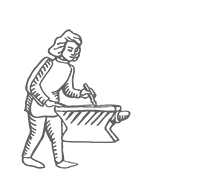|
J. D. Bos an essay on visiting the Museum of Russian Icons [ Part 1 | Part 2 | Part 3 | Part 4 | photo gallery]
I think of this fragment from a letter by Machiavelli as I sit in the quiet dark and ruminate. I am behind bars in a small underground holding cell, a dim glow lighting the brick closing in on either side of me. My chair faces the back wall, and a small ledge with a computer monitor. A notice on the screen says it is out of order; fine, I prefer not to be distracted. For a moment, I fantasize about solitary confinement and how I might spend my time in long-term isolation. Then I turn around and look through the bars of the cell door. Along the wall of the room outside, I can see a row of samovars glimmering in copper, brass, tin, silver, stainless steel. The lighting out there too is soft and diffuse, and the gentle illumination from the can lights in the ceiling oozes over the surface of the urns in a pattern of swirling color. The cell I am in is evidence of the original function of the building which was repurposed to house the Museum of Russian Icons; in its first life, it had been a municipal courthouse. Upstairs, hearing rooms and trials; down here in the quiet dark basement, defendants waiting to see what came next. The cell doors stand open for Museum guests to enter into and take their turn contemplating fate and art and humanity in a space about the same size as a Renaissance gentleman's studiolo. * * * The main gallery spaces are nothing like the monkish cells in the basement, being open, airy and light-filled , with tastefully neutral surfaces of exposed brick, photographic blow-ups, and flat dark gray paint. A central spiral staircase, with wide treads, slices down through three levels of gallery halls. In some rooms, suspended panels provide additional display space; these can be raised as needed to make way for large visitor groups, a feature Lankton specifically directed his designers to implement. The lighting fixtures are LED; the roof is tiled in solar panels. From a spot beside the staircase landing on the first floor, visitors can stand and look up through the open floor and see the image of Christ floating high above on the third floor. A replica of the same image hangs on the first-floor wall, next to the first stop on the docent-led tour: a tight grouping of twenty-seven icons as eclectic as anything hanging on the wall of a Brooklyn apartment. The group brings to mind the iconostasis or icon-screen in traditional Russian churches, which was the icon-covered separating the nave with its rows of pews from the sacred space of the sanctuary. On an adjacent wall, in the corner, is a more modest display, an example of the personal iconostasis traditionally found in Orthodox homes. The krasnyi ugol, meaning "red", "shining" or "beautiful" corner, was where household icons would be hung for family devotion. During the Soviet era, the government required homeowners to replace their icons with images of Lenin and Stalin, Socialist propaganda art, and Party newspaper-posters. The krasnyi ugol-formerly "God's corner"-became the krasnyj ugolok, the "little red corner." Neither the docents nor the gallery guide materials and plaques hint at the political history the icon tradition has endured through, conjuring in my mind all sorts of interesting conversations among the Museum stakeholders about the need for neutrality, lest useful patrons and contacts, in the US or abroad, be alienated and withdraw their support. Then again, these political questions are just a special case of the kinds of questions confronting any museum enterprise: How should we balance the interests of an art- and history-hungry public with the patrimonial claims of the source culture? What is an appropriate way to display objects originally intended for a sacred purpose? Questions which can only ever be answered tentatively, and for the time being. * * * |
ISSN 2150-6795 |




